This week we’re going to take a deep dive into the second stop on my around the world tour last month: Montefalco, Italy. Andiamo!
From Beijing, I traveled to Rome via Air China airlines. While it wasn’t my favorite airline experience, I arrived safely in the Eternal City after around 11 hours in the air. From there, I hopped a train to spend two days in Florence both adjusting to another time zone as well as to the extreme heat and humidity, but primarily to relish in wine, art, and friendship. I’ll share my adventures under the Tuscan sun another day, however. Today, I’m going to focus on the reason for my Italian escapades: “A Montefalco.”
“They” say a picture is worth a thousand words.
While this one picture from Montefalco emotes more than I can pack into a single newsletter, let alone a dozen, I’m still going to share my thousands of words in hopes that you’ll glean a little of that elation and a lot of curiosity. I have a lot to say when it comes to travel in Italy, especially when it pertains to my favorite wine regions, and Montefalco is easily among them.
In the Spotlight - Part I
Wine Region of the Week
Surprise! It’s Montefalco. Montefalco DOC and Montefalco Sagrantino DOC were designated in 1979 with Montefalco Sagrantino DOCG following in 1992. The region of Montefalco encompasses the territory of Montefalco, Giano dell’Umbria, Gualdo Cattaneo, Castel Ritaldi, and part of Bevagna, which all sit in the province of Perugia in central Italy. The region is characterized by gently rolling hills ranging from 720 to 1,550 feet above sea level with various microclimates depending on slope and aspect. The soils can be divided into four sub-zones across the region: fluvial, alluvial, calcareous clays and sands, and marls, and the climate is largely Mediterranean sub-continental. Summers are hot, although not overly humid, and winters are mild with moderate levels of rainfall. Annual precipitation ranges between 30 to 47 inches with most of the rain falling in the autumn months. Montefalco DOC accounts for around 1,250 acres of the region’s vineyards, with Montefalco Sagrantino DOCG coming at 940 acres (up from 150 acres in 1992). Grapes grown include primarily Sagrantino and Sangiovese with a spattering of international varieties for the reds and Trebbiano Spoletino and Grechetto for the whites.
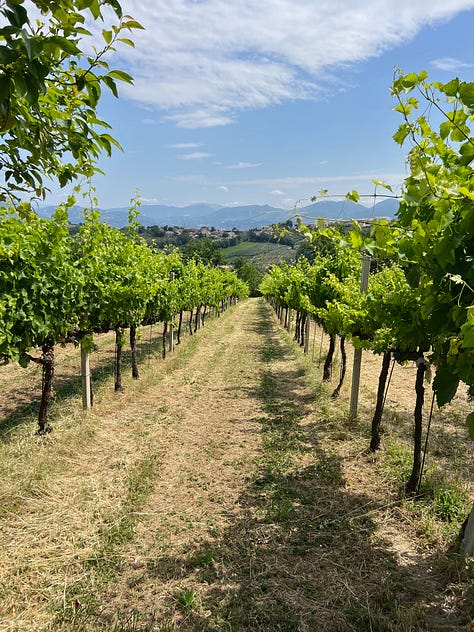
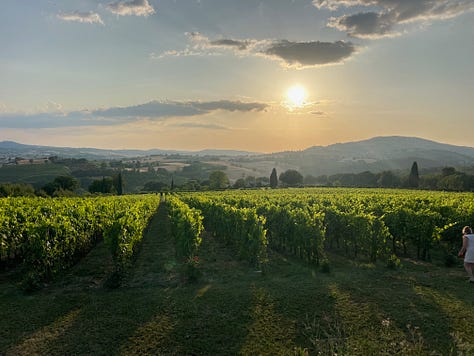
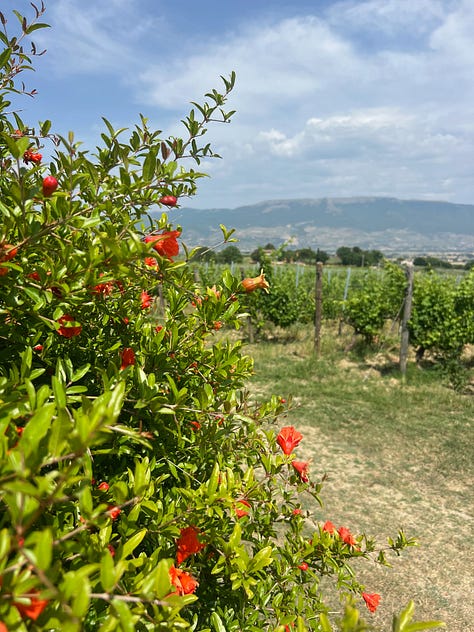
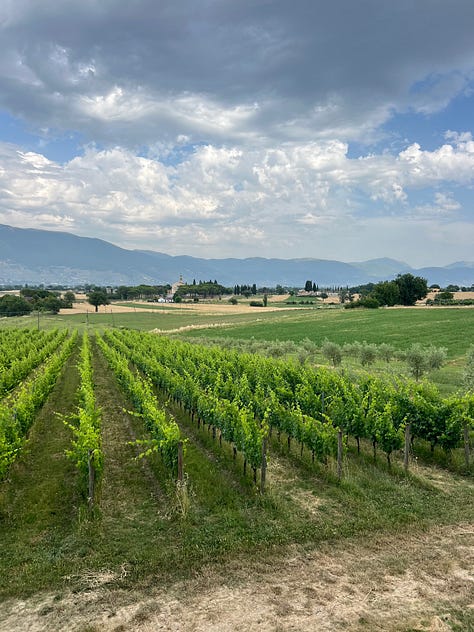
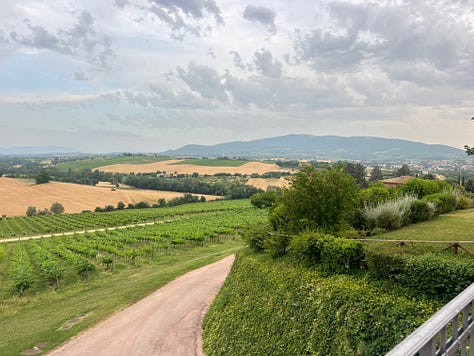
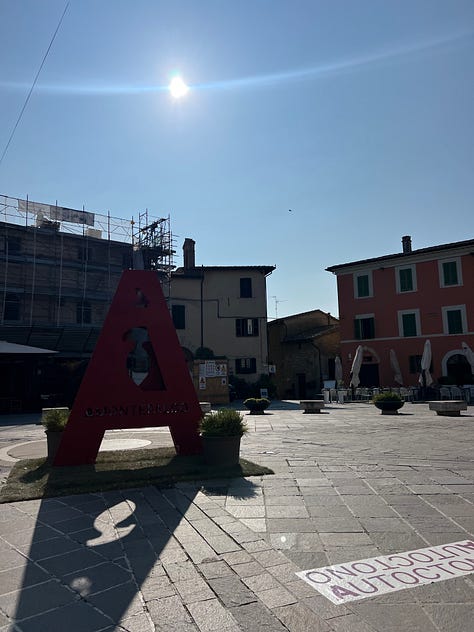
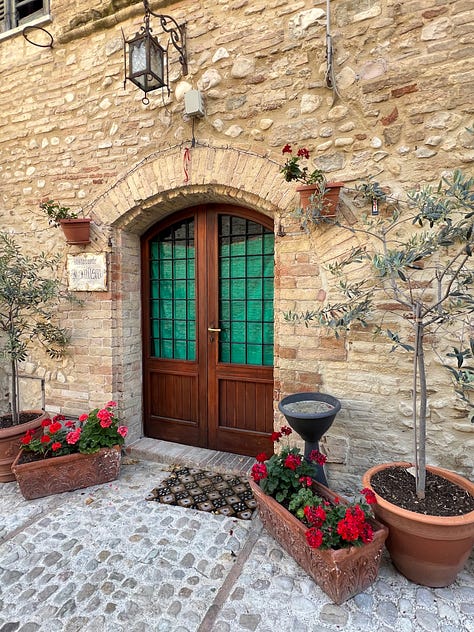
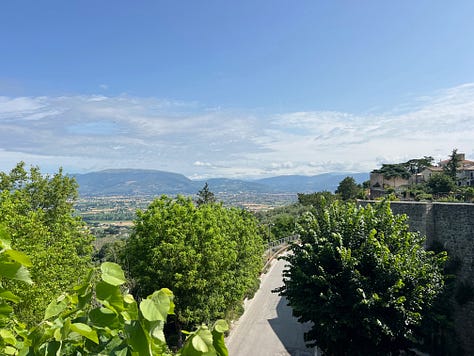
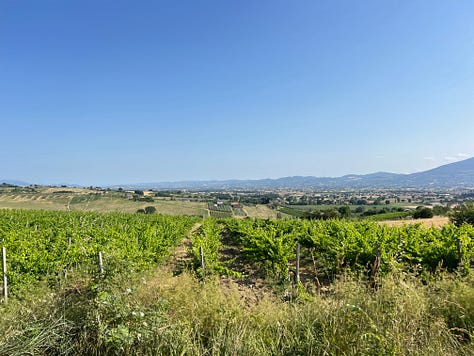
In brief, Sagrantino is, of course the grape of the region, and it’s known for its depth, complexity, length, and tannic structure. The flavor profile ranges from cranberries and black cherries to ripe blackberries and plums, with many spicy and earthy notes including brushy garden herbs, black tea, black olives, pepper, minerality, leather, truffle/mushroom, and anise for a character that is both sweet and savory and can be exceedingly complex. (You can find more “In Depth” coverage on Sagrantino here.) Sangiovese we all know from Tuscany and Chianti, but in Umbria it takes on darker fruit tones while still retaining its mouthwatering acidity. Trebbiano Spoletino is an intense and weighty wine with notable acidity. It’s a versatile grape that can be produced in a variety of styles, but is often noted for savory aromatics, tropical and citrus tones, minerality, and a trace of smokiness that intensifies with age. And Grechetto, the most cultivated indigenous white grape in the region, has intense aromatics with tangy acidity with aromas and flavors typically described as white flowers, tropical, stone, and citrus fruits, as well as traces of herbs and nuts.
The wines of Montefalco:
Montefalco Sagrantino DOCG - 100% Sagrantino, 12 months minimum in oak, 37 months aging of which the last four must be in bottles
Montefalco Sagrantino Passito DOCG (a dessert-style wine) - 100% Sagrantino, grapes are sorted and dried on racks for a minimum of two months before being fermented with the skins, followed by 37 months aging of which the last four must be in bottles
Montefalco Rosso DOC - 60-80% Sangiovese, 10-25% Sagrantino, 0-30% other red grapes, 18 months of aging required
Montefalco Bianco DOC - Minimum 50% Trebbiano Spoletino, 0-50% other white grapes
Montefalco Grechetto DOC - Minimum 85% Greccheto, 0-15% other white grapes
In My Glass
I’m going slightly out of order this week because I though a bit of background about the region would be helpful before slipping into the glass. I lost track of how many wines I tasted in the Montefalco, but it was certainly more than 100, in fact, likely more than 200. I will share many of these in future issues, particularly those that made it into my suitcase, but for now, here are the sips that made the strongest impressions and that offer an overall sense of Montefalco:
2020 Sacciadiavoli Spoleto Trebbiano Spoletino Spumante DOC - It’s not all bold reds in this Central Italian region and some of the bubbles are not to be missed. This mineral-driven, electric and frothy bubbly showcased orchard fruits and florals for a balanced, animating glass. Yes, please. $31
2024 Arnaldo Caprai Montefalco Bianco - My tasting notes, “Very, very drinkable. Crushable.” I mean, do I need to say more? It’s not a serious or complex wine, but it’s damn good; crisp, dry, refreshing with notes of saline-infused citrus. You don’t need to know more. Just do it. $10 in Italy (not yet in US)
2021 Benedetti e Grigi “Macerato” - Not in the states, unsurprisingly as this is the winery’s first release of this label. This is a small-production orange wine that remarkably got my nod of approval. You don’t see many orange wines here. I find many of them to be astringent and either unpleasant or downright gross. Partly its a quality standard, but it’s also just not for my palate. This one, however, got my attention. I enjoyed it to the point it was my chosen glass for lunch. Derived from Trebbiano Spoletino, the wine is naturally fermented in concrete and remains on the skins for 20 days after which it’s moved to stainless. It’s amber in color and aromatic AF with notes of marmalade, orange blossom, and truffle. It’s dry, high in acid with soft, well-balanced flavors of orchard fruits and a salinity driven minerality. It’s rustic, savory, complex and not in the least bit astringent. It totally had me craving a panzanella and roast chicken picnic. Amber is the color of my energy. Rarity.
2018 Saragano Montefalco Rosso Riserva - The second I brought this glass to my nose, I didn’t want to take it away. This Rosso had the type of Italian aromas I live for - intriguing dark fruits, herbs, earth, and leather. It’s a kind of refined rusticity that evokes comfort at the soulful level. It’s a bold fella too - high in all things: acid, tannins, alcohol (a whopping 15.5%) - but with an incredible balance. So much so, you wouldn’t guess it was above 14%. The blend is 60-20-20 Sangiovese-Sagrantino-Merlot. John Coltrane. $38
2021 Tenute Lunelli “Carapace” Sagrantino di Montefalco DOCG - Dear god, at this price point, do not sleep on this one. It’s available stateside and needs to be tasted. I like where this wine is and where it’s headed. Already brimming with aromas of warm spices and dark fruits, this is exceptionally balanced with both bold structure and bright fruit flavors. Its intensity is notable and its length is forever. It’s dark and earthy with seductive hints of polished leather and it’s the wine I tasted blind that inspired the visit referenced below. Make time. $40
This is what I want from a Sagrantino: truffle, dark fruit, soft and dusty, fresh, savory. It came home with me. Full stop. $70
In the Spotlight - Part II
Winery of the Week
The Lunelli family is best known for their Ferrari Trento sparkling wines from the Trentodoc region in Northern Italy, which was founded in 1902 by Giulio Ferrari. Wanting to expand their operations to other regions of Italy, the Lunelli family began looking for properties in Tuscany and through their exploration discovered Sagrantino and the unique terroir of neighboring Umbria, specifically in Montefalco. In 2001, fascinated by the power and longevity of the region’s wines and their ability to express a definitive sense of place, the Lunelli family purchased Tenuta Castelbuono, an estate in the communes of Bevagna and Montefalco with 75 acres planted to vine.
The Lunelli family converted the vineyards to organic farming and planted new vines based on a clonal selection of the existing old vines. They released their first vintage of Montefalco Sagrantino in 2003 with Montefalco Rosso following in 2004. To-date the estate only produces red wines on which they have invested a significant amount of time and effort to increasingly refine: a Montefalco Sagrantino DOCG, a Montefalco Rosso Riserva DOC, a Montefalco Rosso DOC, and a Montefalco Sagrantino Passito DOCG. Their goal is to produce Sagrantinos that are less defined by tannins, but that still capture the spirit, essence, and characteristics of the grape and the integrity of the place from which it hails. To achieve their desired style, the winemaking team has worked with and consulted local producers - most of whom are native to the region and have been producing Sagrantino for decades - to develop a better understanding of the grape from vine to bottle. They have also incorporated some of their own winemaking techniques from other regions as well as lent their decades of expertise to the process. A few of the behind-the-scenes winemaking steps include rigorous sorting in the vineyards and at the winery, limiting oak barrel usage to the Cabernet Sauvignon and Merlot for the Montefalco Rossos, and using exclusively puncheons, large oak casks, and amphora for the Sagrantino and Sangiovese.
Tenute Lunelli Castelbuono also offers wine tasting experiences from their immaculate grounds with stunning views of Montefalco’s hilly countryside and the otherworldly tasting room designed by Arnaldo Pomodoro - the “Carapace.” The winery is open daily with tours and tastings available by appointment.
A Personal Note:
After tasting Tenute Lunelli Castelbuono 2003 Sagrantino di Montefalco (their first release) alongside their “Carapace” Montefalco Sagrantino DOCG 2020, I can personally attest that they are achieving their winemaking goals. The 2003, while glorious in every respect - it was a “pinch me moment” - was still dominated by its tannic structure, even after 22 years, with the tertiary flavors taking more of a backseat. In contrast, the 2020 at five years of age demonstrated more soft, well-integrated and refined tannins while still delivering the flavors, structure, and integrity of Sagrantino. This is a producer to note and wines to experience.
In the Moment
I first met Alessandro Lunelli at the master class for A Montefalco. After a brief conversation about being outsiders in Montefalco but absolutely finding it to be “home,” he invited me to visit the family winery (which was not on my initial schedule) for a tour and tasting. Later that day, during my blind technical tasting of the 2021 vintage, I unknowingly highlighted one of the Lunelli wines as notable and outstanding, and upon reveal of the wine I immediately decided to reach out about that tasting. Alessandro and his vineyard director Luca Capaldini graceously arranged an early morning pick-up for me the very next day, ahead of the scheduled activities. After a beautiful drive, I walked through the gravel parking lot and past a set of tall trees to an astonishing view of an estate of which I cannot adequately describe in words; to do so would be an injustice to the art, architecture, and emotion of the space.
What I can tell you is what struck me most - aside from the ethereal winery and gorgeous wines - is that the Lunelli family chose Montefalco, and to me, that is a testament to the region. Montefalco is home to 73 wine producers of which the majority are native to the region. It is a collaborative (surprisingly so) wine industry, welcoming to outsiders and one another, but it is not a region as well-known as Tuscany or Piemonte, or even Sicily or Veneto. And so, when a winemaking family is looking to expand operations to offer wines representative of Italy’s greatest regions - well, that says a lot. But just in case it doesn’t say enough, I’ll let Alessandro tell you more.
If imitation is the sincerest form of flattery, the Lunelli’s foray into Montefalco tells you what I already believed with my whole heart - Montefalco and its Sagrantino deserve a place on the world stage. It’s why the wine is in my top 5 for red wines of all-time. And I’d say, after almost 25 years in the region, with wines uniquely their own but with integrity of place, Lunelli may just find they are now a well-engrained part of the fabric of Montefalco. And you never know, they may be a part of what inspires other locals and outsiders alike to take a leap into the region and the craft.
In the Room Where It Happened
A Montefalco is a four-day promotional event hosted by the Consorzio Tutela Vini Montefalco (aka the regional wine organization in Montefalco) designed to showcase the DOCG and DOC wines of the area. Unlike the traditional “anteprime” events at which the newly released vintage is shared, A Montefalco takes both a vertical and horizontal approach, sharing the various vintages and wines currently on the market. It’s an educational immersion complete with master classes, tastings, winery visits, local explorations, and cultural exchanges.
The home base for the event is in the walled, old town of Montefalco where the stone streets are narrow, hilly, and dotted with flower adorned shops, restaurants, homes, churches, and cafes. Referred to as “the balcony of Umbria” for its panoramic views of the surrounding countryside and vineyards, Montefalco traces its origins to the Etruscan era and Roman times. The well-preserved city walls were constructed in the 13th and 14th centuries with three gates that allow entrance. The main square, the Piazza del Comune, sits at the highest point within the walls and is where you’ll find several restaurants dishing out local cuisine and wines. It was also our meeting point each morning.
A typical day at A Montefalco began between 8:30 and 9 with the first days offering classes and welcome sessions. The remainder of the days were spent visiting the wineries we chose in advance of the event, typically four to five per day. There was also time built in for the tasting salon at which you could taste a range of wines - whites to reds, still to sparkling, and dry to sweet - either blind or not. I first opted for the 14 2021 Montefalco Sagrantinos blind, after which I selected a few sparkling wines, Montefalco Rossos and Montefalco Rosso Riservas.
A Montefalco was an incredible and immersive opportunity which lent me a greater understanding of the region, its people, culture, soils, climate, vines, and wines. It’s a region I knew and loved, and one, after this last experience, I continue to hold in high esteem. As for the vineyards, they are many with a mixture of vine training methods including prune-spurs, cordon and guyot. There are roughly 73 wine producers making around 1.8 million bottles of Montefalco Sagrantino DOCG and 4 million bottles of Montefalco DOC, of which red wines account for 88%. Of those wineries, there is a mix of mostly small, rustic producers with intimate tasting rooms, to a growing number of larger-scale wineries with more luxurious accommodations, all of which are worth experiencing.
Being a fanatic for Sagrantino, I spent the majority of my time dedicated to the DOCG wines as well as the Montefalco Rossos. I did enjoy the occasional Grechetto and dabbled in the Trebbiano Spoletino, but admittedly, it was not my focus. I will cover Trebbiano in a future issue, its growing prominence, characteristics, potential future, and my personal opinions, but for now, let’s talk red wines and specifically the 2021 vintage.
First, let me say, I’m excited at the potential of these newly released wines. There is a growing range in expression from the traditional tannic-ageworthy styles to the more innovative, refined styles using less oak and more concrete and amphora. And in my opinion, there’s room for both. I love the how the traditional Sagrantino ages. There’s something magical, transcendent even, about the dusty tannins sprinkled across the potpourri of dried red berries, flower petals, earth, worn leather, and a lifting hint of cola that an aged Sagrantino can bring. And I fully intend to continue buying and aging those beauties. That said, I’m all for this new, gentler style of Sagrantino, that particularly when done well retains the character of the grape, upholds a solid structure, but softens that tannic kick. Instead of a youthful vintage lending a slap across the face, it’s more like getting a tight bear hug, which means not only do I get to drink Sagrantino more often, I also have strong cellar defenders for my aging bottles.
As for the scientific side of the 2021 vintage, it saw a harsh winter with regular rains and frost into early April. The lower temperatures did delay budding and rains continued through May, but the summer was both hot and dry causing stress for the vines and decreasing some of the production (meaning the grapes that produced benefited from extra energy from the plant and greater concentration). Fortunately for Sagrantino, it’s a late ripening variety and the temperatures into October cooled helping the grape to retain its acidity through the growing season. The overall harvest presented as balanced, healthy grapes with strong aromatics and notable sugar levels. The tannins were “rigorous,” but will be balanced by the strong fruit profile, acid levels, and alcohol content. In other words, based on the vintage, the 2021s have significant aging potential. And based on my personal tasting assessments and notes, I would say this vintage certainly bodes well for aging - and some of them for drinking.
Other notable vintages: 2020, 2019, 2018, 2016 (my summer of Sagrantino), and 2015. I would also say for the older bottles anything from 2000 to 2013 (with the exception of 2002), if stored properly, have to potential to seduce. And honestly, if you’re lucky enough to find anything from before the turn of the century, who cares, just try it and savor it for what it is - an opportunity to delve into the past, be it good, bad or indifferent, it’s a gift.
In the Know
The word “Sagrantino” is likely derived from a story about Emperor Federico in 1240. He lived in an Umbrian castle called Coccorone, meaning “top of the hill.” The emperor was fascinated by the local “sacred” falcons which contracted a deadly disease. The emperor enlisted the help of Theodore of Antioch, a philosopher and doctor, whose solution was an infusion of sugar, alcohol, and violet petals. Time being of the essence, they used the local sweet wine as the base for the concoction to which they added violet petals. The falcons are said to have drunk the wine and been cured and as a result the local wine became known as Sagrantino, from falco sagro or sacred falcon. The village’s name was also changed from Coccorone to Montefalco - the falcon’s mountain.
In Memoriam
Arnaldo Pomodoro - (June 23, 1926 – June 22, 2025)
According to me, sculpture must be projected into space in order to remove, as far as possible, the weight from the material and the work's fixed base. I have always tried to express movement as an intensification of a condition of imbalance in order to create a striking contrast to any stasis or any reached or predictable order.
— Arnaldo Pomodoro
Arnaldo Pomodoro was an award-winning and renowned Italian sculptor and artist best known for his “Sfera con Sfera” (Sphere within Sphere) sculptures. His works are found around the world from the Guggenheim and the United Nations Headquarters in New York to the Vatican Museums and Trinity College Dublin. He is also the creator of Tenute Lunelli’s “Carapace” winery in Montefalco, which I experienced only days before his passing.
A friend of the Lunelli family, Mr. Pomodoro had previously created the “Centenarium,” a sculpture commemorating 100 years of the Ferrari winery. When the Lunelli’s proposed Mr. Pomodoro create a livable structure in which they could make wine, he enthusiastically accepted the challenge of creating a piece that combined sculpture and architecture and which integrated the landscape on which it would be built with a functional space for making wine.
Through his “Carapace,” Mr. Pomodoro sought to integrate the structure with the surrounding hills. The shape, reminiscent of a tortoise, represents stability and longevity as well as a union between land and sky. But it is one thing to sculpt a piece of art, to turn that artistic vision into a functional building however is a feat that had yet to be achieved. It takes significant time, resources, skill, custom features, and of course an architect, in this case, Giorgio Pedrotti. It took six years to complete the Carapace with its fissured, copper dome and ziggurat* style interior - the first livable sculpture in the world. Entering the Carapace will hitch your breath, making the impossible appear possible. Mr. Pomodoro, himself said of the Carapace, “For the first time in my life I felt the excitement of being able to walk, talk, and drink inside one of my own works.”
The “greats” are few and far between, but Mr. Pomodoro undoubtedly was one and he has left this world a legacy of beauty, thoughtfulness, and vision.
*The ziggurat, a stepped, pyramid like form with a temple at the top, was likely inspired by the Tower of Babel known as Etemenanki, which translated to, "house of the foundation of heaven and earth.” Fitting for Carapace.
In the Hopper
Phew! I told you I have a lot to say from my 21 days around the globe and we’ve only scraped the surface. I’ll be back next week with my macro-take on all things Languedoc. And if you’re on Instagram, you’ll find my current European location in the stories. This trip isn’t a press trip. It’s a holiday. As such, my socials will see less, but you’ll see more - eventually!












